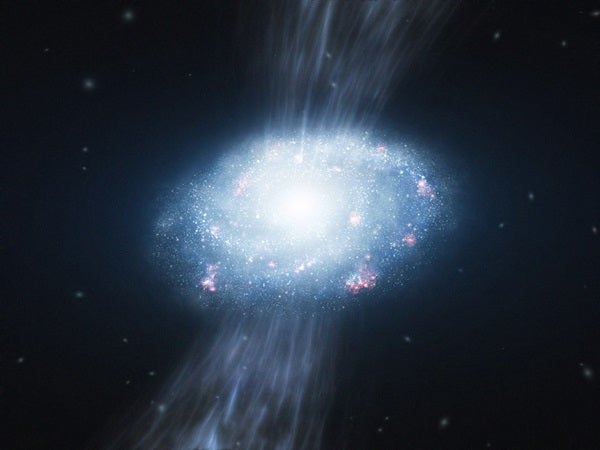New observations from the European Southern Observatory’s (ESO) Very Large Telescope (VLT) have, for the first time, provided direct evidence that young galaxies can grow by sucking in the cool gas around them and using it as fuel for the formation of many new stars. In the first few billion years after the Big Bang, the mass of a typical galaxy increased dramatically, and understanding why this happened is one of the hottest problems in modern astrophysics.
The first galaxies formed before the universe was less than 1 billion years old and were much smaller than the giant systems, including the Milky Way, we see today. So, somehow the average galaxy size has increased as the universe has evolved. Galaxies often collide and then merge to form larger systems, and this process is certainly an important growth mechanism. However, an additional, gentler way has been proposed.
A European team of astronomers has used ESO’s VLT to test this very different idea — that young galaxies can also grow by sucking in cool streams of the hydrogen and helium gas that filled the early universe and forming new stars from this primitive material. Just as a commercial company can expand either by merging with other companies or by hiring more staff, young galaxies could perhaps also grow in two different ways — by merging with other galaxies or by accreting material.
“The new results from the VLT are the first direct evidence that the accretion of pristine gas really happened and was enough to fuel vigorous star formation and the growth of massive galaxies in the young universe,” said Giovanni Cresci from the Osservatorio Astrofisico di Arcetri, Italy. The discovery will have a major impact on our understanding of the evolution of the universe from the Big Bang to the present day. Theories of galaxy formation and evolution may have to be rewritten.
The group began by selecting three distant galaxies to see if they could find evidence of the flow of pristine gas from the surrounding space and the associated formation of new stars. They were careful to make sure that their specimen galaxies had not been disturbed by interactions with other galaxies. The selected galaxies were regular, smoothly rotating disks similar to the Milky Way, and they were seen about 2 billion years after the Big Bang (at a redshift of around three).
In galaxies in the modern universe, the heavy elements are more abundant close to the center. But when Cresci’s team mapped their selected distant galaxies with the spectrograph on the VLT, they were excited to see that in all three cases there was a patch of the galaxy close to the center with fewer heavy elements, but hosting vigorously forming stars. This suggests that the material to fuel the star formation was coming from the surrounding pristine gas that is low in heavy elements. This was the smoking gun that provided the best evidence yet of young galaxies accreting primitive gas and using it to form new generations of stars.










